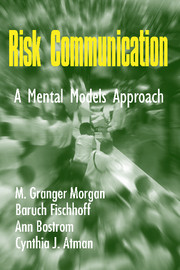Book contents
- Frontmatter
- Contents
- Preface
- Risk Communication
- 1 INTRODUCTION
- 2 OUR MENTAL MODELS APPROACH
- 3 CREATING AN EXPERT MODEL OF THE RISK
- 4 MENTAL MODELS INTERVIEWS
- 5 CONFIRMATORY QUESTIONNAIRES
- 6 DEVELOPMENT AND EVALUATION OF COMMUNICATIONS
- 7 CASE STUDIES: APPLICATIONS TO ENVIRONMENTAL RISKS
- 8 A MENTAL MODELS APPROACH TO HIV/AIDS
- 9 SOME CONCLUDING THOUGHTS
- Appendix A Brochure on global warming and climate change
- Appendix B Brochure on fields from electric power
- Appendix C Risk communication materials on HIV/AIDS
- Appendix D Sample transcripts of mental model interviews
- Index
4 - MENTAL MODELS INTERVIEWS
Published online by Cambridge University Press: 05 June 2012
- Frontmatter
- Contents
- Preface
- Risk Communication
- 1 INTRODUCTION
- 2 OUR MENTAL MODELS APPROACH
- 3 CREATING AN EXPERT MODEL OF THE RISK
- 4 MENTAL MODELS INTERVIEWS
- 5 CONFIRMATORY QUESTIONNAIRES
- 6 DEVELOPMENT AND EVALUATION OF COMMUNICATIONS
- 7 CASE STUDIES: APPLICATIONS TO ENVIRONMENTAL RISKS
- 8 A MENTAL MODELS APPROACH TO HIV/AIDS
- 9 SOME CONCLUDING THOUGHTS
- Appendix A Brochure on global warming and climate change
- Appendix B Brochure on fields from electric power
- Appendix C Risk communication materials on HIV/AIDS
- Appendix D Sample transcripts of mental model interviews
- Index
Summary
Our approach assumes that sound risk communication requires an understanding of both the risk and audience members' current beliefs about it. Chapter 3 explored how to develop the expert description of the risk in the form of an influence diagram. This chapter describes how to design and conduct mental models interviews, the critical first step in learning what people know already. Chapter 5 explains how to develop structured, confirmatory questionnaires that can be easily and quickly administered to larger samples of people, in order to estimate the prevalence of the beliefs revealed in the mental models interviews.
Designing and Testing the Interview Protocol
Strategy
The expert influence diagram must be substantially completed before designing the interview, because it guides the topics to be covered.
The goal of the mental models interview is to get people to talk as much as possible about how they think about the risk while imposing as little as possible of other people's ideas, perspectives, and terminology. Our strategy for accomplishing this goal – and the name used for our overall approach – draws on the long tradition in cognitive psychology of studying people's mental models. As early as the 1930s, experimental psychologists realized that understanding behavior in complex, uncertain environments required considering the tacit theories that people (and even other animals) developed to cope with them (e.g., Bartlett, 1932; Tolman, 1932).
- Type
- Chapter
- Information
- Risk CommunicationA Mental Models Approach, pp. 63 - 83Publisher: Cambridge University PressPrint publication year: 2001



